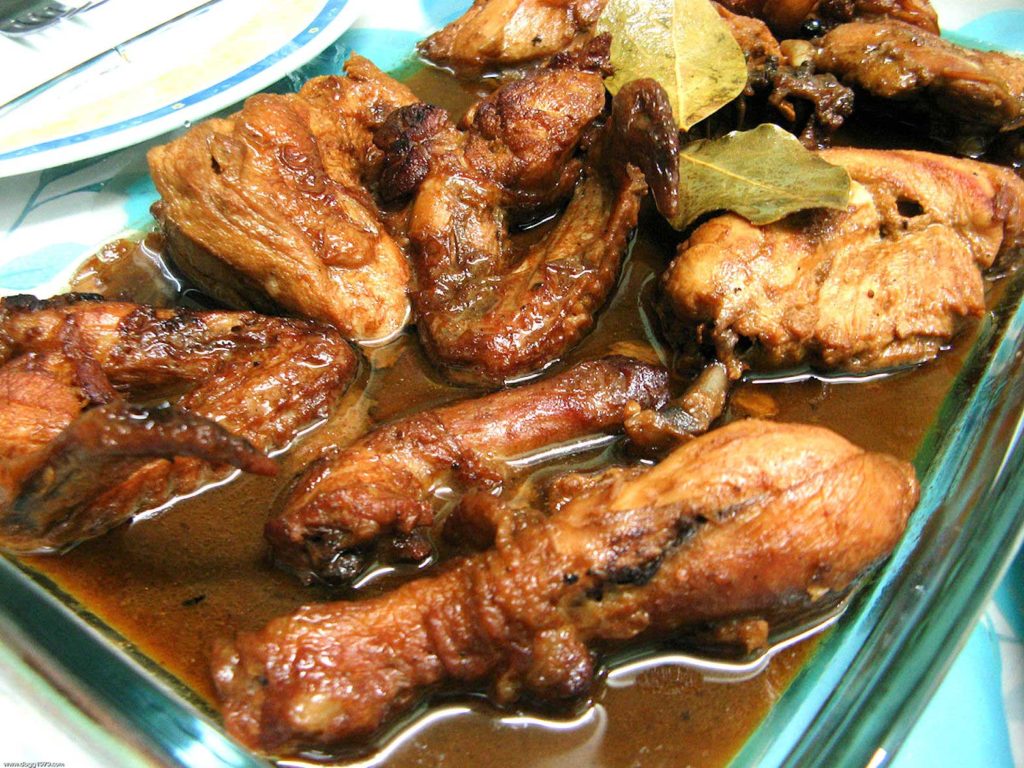
Chicken adobo
NEW YORK— Adobo is arguably the Philippines’ most well-known dish, although a similar case can be made for lechon, or spit-roasted pork. There are probably at least as many recipes for cooking adobo as there are islands—more than 7,000. As with snowflakes, it is well-nigh impossible distinguishing one adobo dish from another, just from appearance. After all, the ingredients used in preparing the marinade—in Spanish, the verb “adobar” means to marinate or pickle—for the chicken and/or pork are the same: soy sauce, vinegar, garlic, peppercorn, and bay leaf.
The marinade can be used for other meats or even fish, though the latter version is quite rare. Whether in the northern reaches of Luzon or the central islands of the Visayas or Mindanao, adobo has a thousand and one variations. I like to think of the core as something to play with, in the way that melody anchors a jazz riff, a platform from which a jazz musician can take off, stressing one element over another, always respecting the melody, and somehow transfiguring it. That singular metamorphosis is what makes it art , the melody at once new and familiar.
One can add almost anything to the adobo marinade, making it unique and at the same time pleasurable. The emphasis can be on the vinegary flavor, or on the soy saltiness, and even then there are different types of vinegar and soy sauce to choose from. Chili peppers will naturally add spice to the dish. I’ve known versions that incorporate lotus root or flowers, prunes, or almonds, as well as herbs such as oregano, parsley, and thyme. One can add a bit of sugar, to balance the acidic and salty tastes, and so on.
Part of the joy comes from seeing how one can come up with an adobo that is different, deviating from the classic recipe yet at the same time mindful of its origins. One can say the process of cooking adobo in a particular manner can also be a metaphor for how one progresses through life.
You won’t lack for arguments from folks who believe fervently that their adobo is unrivalled, and perhaps one metamorphosis can be seen as definitive, but that is a judgement left to individual taste. No serious jazz musician would ever declare that his or her rendition should be the standard by which all other versions must be compared. But this is exactly what seems to be happening with the Philippine Department of Trade and Industry’s recent decision to have its Bureau of Standards develop official guidelines on how to cook adobo. The DTI’s rationale? “Standardizing the basic cooking technique for Philippine adobo will help ordinary citizens, foodies, and food businesses determine and maintain the authentic Filipino adobo taste.”
Ah, how little faith government has in the person on the street’s culinary expertise and idiosyncrasies!
Should this undertaking proceed, the DTI has set its sights on even more fare that can be considered comfort food for the “ordinary citizen.” Among its targeted dishes are sinigang, lechon, and sisig. All in the name apparently of “authenticity.”
How does one come to declare one version “authentic” and another not? Whole tomes have been written on this topic, academic conferences periodically examine this notion ad absurdum. Amy Besa, the well-known restaurateur, and co-author with her husband, the chef Romy Dorotan of Memories of Philippine Kitchens—the two own and manage Purple Yam restaurant in Brooklyn—had strong feelings regarding DTI’s attempt to standardize adobo. In the online magazine Positively Filipino’s recent feature, by Rene Astudillo, Besa is quoted as declaring, “The question is WHO owns our food ways? We all do. The best way to preserve our food is when families pass down their heritage recipes to the next generation. The operative word is SHARING recipes to show the depth and richness of our culinary heritage. To standardize and codify means to EXCLUDE infinite ways of reimagining our food. INCLUSION and EMBRACING regional differences should be the spirit in which we learn about our food.”
Or as the French, no slackers when it comes to food, would say, Vive la différence!
The curious thing is, why bother? Doesn’t the DTI have more pressing matters to attend to? Might whoever thought of this have been DUI? Or suffering from DTs? How about setting standards for honesty and integrity, two distinct sauces rarely seen in government these days?
It’s a government that has since 2016 placed the nation in a fine pickle. And If there is any one dish that the DTI may consider setting standards for, given the current dispensation’s penchant for bloodletting, it would be dinuguan, our version of blood pudding—seemingly the president’s favorite dish. The DTI could formulate—standardize—a recipe and name it Dinuguan à la Duterte, a fitting tribute to a man whose vocabulary is dominated by one four-letter word: Kill. Copyright LH. Francia 2021







